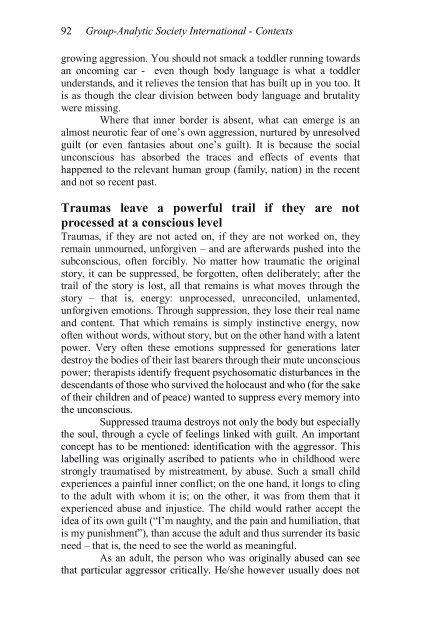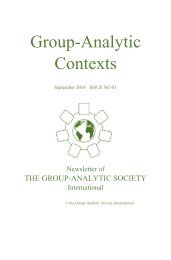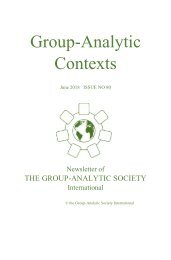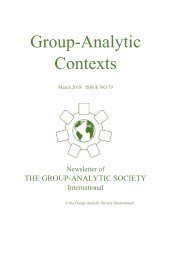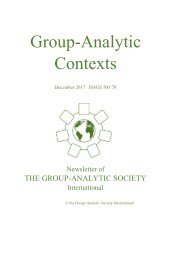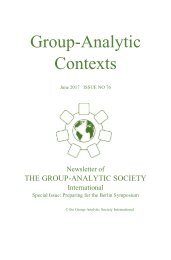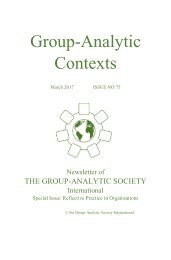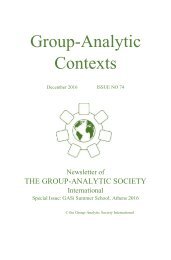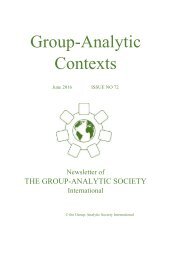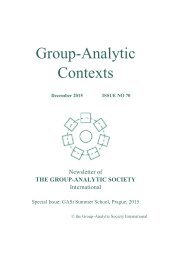Group Analytic Contexts, Issue 77, September 2017
Newsletter of the Group Analytic Society International
Newsletter of the Group Analytic Society International
You also want an ePaper? Increase the reach of your titles
YUMPU automatically turns print PDFs into web optimized ePapers that Google loves.
92 <strong>Group</strong>-<strong>Analytic</strong> Society International - <strong>Contexts</strong><br />
growing aggression. You should not smack a toddler running towards<br />
an oncoming car - even though body language is what a toddler<br />
understands, and it relieves the tension that has built up in you too. It<br />
is as though the clear division between body language and brutality<br />
were missing.<br />
Where that inner border is absent, what can emerge is an<br />
almost neurotic fear of one’s own aggression, nurtured by unresolved<br />
guilt (or even fantasies about one’s guilt). It is because the social<br />
unconscious has absorbed the traces and effects of events that<br />
happened to the relevant human group (family, nation) in the recent<br />
and not so recent past.<br />
Traumas leave a powerful trail if they are not<br />
processed at a conscious level<br />
Traumas, if they are not acted on, if they are not worked on, they<br />
remain unmourned, unforgiven – and are afterwards pushed into the<br />
subconscious, often forcibly. No matter how traumatic the original<br />
story, it can be suppressed, be forgotten, often deliberately; after the<br />
trail of the story is lost, all that remains is what moves through the<br />
story – that is, energy: unprocessed, unreconciled, unlamented,<br />
unforgiven emotions. Through suppression, they lose their real name<br />
and content. That which remains is simply instinctive energy, now<br />
often without words, without story, but on the other hand with a latent<br />
power. Very often these emotions suppressed for generations later<br />
destroy the bodies of their last bearers through their mute unconscious<br />
power; therapists identify frequent psychosomatic disturbances in the<br />
descendants of those who survived the holocaust and who (for the sake<br />
of their children and of peace) wanted to suppress every memory into<br />
the unconscious.<br />
Suppressed trauma destroys not only the body but especially<br />
the soul, through a cycle of feelings linked with guilt. An important<br />
concept has to be mentioned: identification with the aggressor. This<br />
labelling was originally ascribed to patients who in childhood were<br />
strongly traumatised by mistreatment, by abuse. Such a small child<br />
experiences a painful inner conflict; on the one hand, it longs to cling<br />
to the adult with whom it is; on the other, it was from them that it<br />
experienced abuse and injustice. The child would rather accept the<br />
idea of its own guilt (“I’m naughty, and the pain and humiliation, that<br />
is my punishment”), than accuse the adult and thus surrender its basic<br />
need – that is, the need to see the world as meaningful.<br />
As an adult, the person who was originally abused can see<br />
that particular aggressor critically. He/she however usually does not


